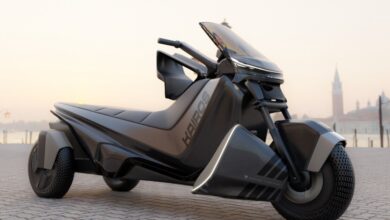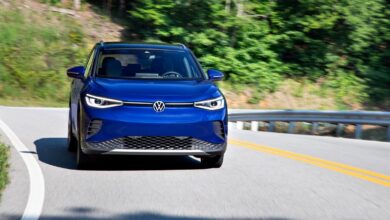Tariffs against America

Unlock the US Election Countdown newsletter for free
The stories that matter on money and politics in the race for the White House
The US tariffs on Chinese green tech announced this week are rank electioneering. “So you like the sound of Trump’s mooted 10 per cent across-the-board tariff? Try a 100 per cent duty on Chinese electric cars!” seems to be what President Joe Biden wants voters to hear. In this mine-is-bigger-than-yours contest, don’t be surprised if Donald Trump soon promises 1,000 per cent tariffs. As for the real effects, though, here are some thoughts on why they may do as much if not more for Europe as for the US.
Electioneering aside, the new suite of tariffs — the whole range is set out by my colleague Aime Williams here — marks a turn in the long-running tug of war between the de-couplers and the de-riskers in the US administration. For a while it looked like Treasury secretary Janet Yellen had prevailed over the protectionist-security complex in favour of “mere” de-risking, in step with the European Commission’s approach. There is a tale yet to be told about how the pendulum swung back.

I suppose many in the administration see the tariffs as buttressing the green industrial agenda of the Inflation Reduction Act. The argument would be that just like the IRA increased the incentives for US consumers to buy US-made electric vehicles and other green tech (through subsidies), and the rewards from producing them in the US (through tax credits), the tariffs will further encourage domestic manufacturers to expand by raising even more the relative price of Chinese substitutes (or forestall a fall in that relative price). There is a certain logic here, which suggests the tariffs are not merely voter bait but a substantial part of the programme also for a second Biden term.
But it is a logic that’s naive if not flawed. There are a lot of reasons to think green tech protectionism will hurt the industrial transformation the Biden administration wants to engineer.
Take the doubling of the tariff on solar cells (from 25 to 50 per cent) and reflect on another time this sort of tactic was used to protect a domestic industry: when the EU placed restrictions on Chinese solar panel imports in 2013 because of the threat to until-then successful European (especially German) manufacturers. It didn’t work. The domestic industry declined anyway, and so did the uptake of solar electricity generation. As I have written before, a better policy would have been to welcome the Chinese imports but increase demand so much that even more expensive domestic producers could be confident in having a market. Europe would have been much further along its energy transformation today.
We should expect similar consequences from the new US tariffs. Take the headline-grabbing change, to a 100 per cent duty on imported Chinese EVs. So few of these are imported to the US at the moment that the number basically can’t fall (my colleagues cite a figure of 2 per cent of all EV imports — so a razor-thin sliver of the import share of the small EV share of US car purchases). The idea is, presumably, that it will simply forestall a repeat of the soaring Chinese EV shipments to Europe and that this will make US EV makers more secure.
But look, first, at some of the other tariffs. Those on batteries, magnets and critical minerals jump to 25 per cent. Those on semiconductors to 50 per cent. All of these will drive up the price of important inputs into EV and other green tech manufacturing (even domestically produced ones, because that’s what tariffs do).
More importantly, the whole protectionist move actually counters the most important way in which the IRA looked like it would work. Its transformative effect was not just the subsidies, but the confidence it gave US consumers and producers — as well as investors elsewhere — that a big, stable market for EVs, renewable energy equipment and other green tech would come into being, and that there was money to be made by joining it.
For this reason, an inflow of Chinese EVs — especially in the low-price segment where China’s industry excels in — could have been a good thing for the IRA’s goals. A much larger uptake of EVs by consumers would have accelerated the shift from fossil-fuelled to electric cars, by creating more demand for charging stations, encouraging the training of EV mechanics, familiarising buyers with how they work, and so on. And all that would have been very good for the US-based manufacturers of EVs and of the inputs going into them.
The best-case scenario is that these tariffs will not do too much harm to America’s fledgling green industrial shift. The bigger effect may, paradoxically, be in Europe.
One is at the political level. Europeans freaked out, to use the technical term, about the IRA. There is a good chance they will freak out again over these big tariff jumps. Not because they hurt European exporters (they benefit them, on which more in a moment), but because they show the scale and speed with which the US government can favour its industry (or do what it thinks favours it). The contrast with the EU’s laboured policymaking process and its fragmented and confusing industrial policy tools is stark, as will no doubt be self-flagellatingly pointed out left, right and centre in the months to come. Don’t be surprised to hear European industry lobbies bleat about how they are now left even more exposed to unfair Chinese competition.
The fact is, of course, that EU exporters are now in a much more price-competitive position in the US market than they were, since Chinese rivals just became 60 per cent more expensive. If anything, this mitigates a little the discriminatory measures EU exporters complain about in the IRA. And US-based EV plants will now want to see if they can replace Chinese batteries with non-Chinese ones, widening the market for EU manufacturers.
European policymakers could undo all of this if they were tempted to copy US protectionism and push global green tech trade further towards fragmentation — indeed there are already calls to match the US tariff move. That would not be a good look for a continent with the ambition to be the first to go carbon-neutral. Instead, the EU could show that there is a better way of combining openness, industrial strategy and strategic nous. That would be to accelerate green tech adoption through subsidies and procurement policies, thereby securing a big enough market that European manufacturers are confident to expand, while making use of Chinese imports to keep all this affordable and intensify competitive pressure on domestic producers (subject to carbon taxes on the border, of course).
On the whole, Washington’s latest policy move will probably push both global decarbonisation and a US industrial transformation a little further out of reach. That is enough for Europeans to lament, without having to pretend they are hurt commercially.
Other readables
Chinese President Xi Jinping’s visit to Europe was a huge missed opportunity for France and Emmanuel Macron.
My colleagues have tracked down the smuggling routes that let Russian airlines get hold of sanctions-hit aeroplane parts.
How did Sweden come to have one of the world’s highest concentration of billionaires? A BBC podcast explores.
Some good news: EU carbon emissions fell by 4 per cent from the end of 2022 to the end of 2023.
Raiffeisen Bank has been a rogue operator in Russia for too long, writes FT deputy editor Patrick Jenkins.



